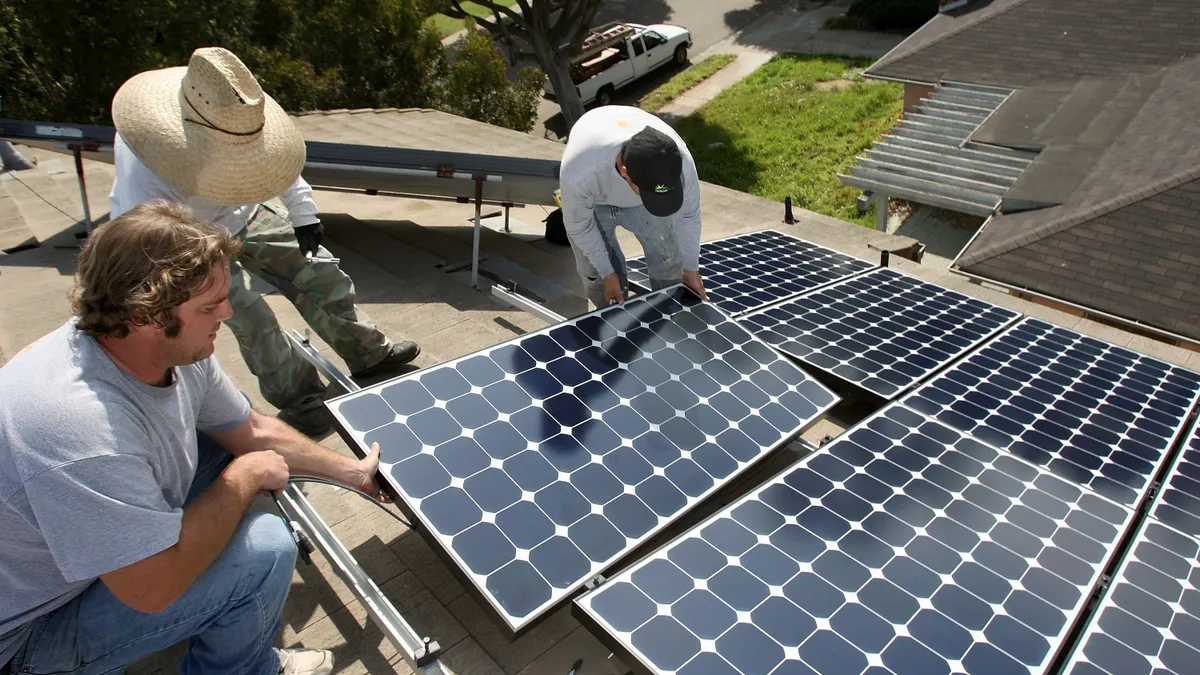Dive Brief:
- People of color and women are "vastly underrepresented" in clean energy jobs compared to the U.S. workforce at large, and many underrepresented groups lost ground between 2017 and 2020, according to a report released last week by BW Research Partnership, E2, and a coalition of clean energy industry groups.
- Underrepresented racial and ethnic groups hold just four in ten clean energy jobs, according to the report. Black workers were the most poorly represented in the sector, composing 8% of clean energy jobs compared to 13% of the U.S. workforce as a whole.
- With people of color and women now representing the majority of young students in the U.S., clean energy companies could face labor shortages in the future if they fail to recruit more diverse workers, according to Paula Glover, president of the Alliance to Save Energy. "If you've done nothing and know nobody, then your roadway is a lot longer than someone who has been at it a long time," she said.
Dive Insight:
Clean energy may be one of the fastest-growing job sectors in the U.S., according to the partners behind a new report on diversity in the sector, but even with the growing emphasis on energy equity, the growth of renewables hasn't translated to more jobs for underrepresented populations.
White, non-Hispanic men hold roughly three-fifths of jobs in wind and solar generation, energy efficiency, grid modernization and electrification, according to last week's report, causing E2 Executive Director Bob Keefe to remark at a press conference on the report that "the face of clean energy is predominantly White and male."
"We know that clean energy has become a huge part of the American economy, and it's only going to get bigger," Keefe said, noting that clean energy now employes 3 million workers, more than the fossil fuels industries, and that the pay is typically better than U.S. median. "But what we also know is this: the overwhelming majority of people getting these jobs are White and they are male."
Hispanic and Latino workers held 16.5% of clean energy jobs and 18% of total U.S. jobs.
Women held 27% of clean energy positions as of 2020, despite representing nearly 50% of the U.S. workforce.
Asians, Pacific Islanders and Native Americans actually held a greater percentage of clean energy jobs compared to their share of total U.S. jobs, according to the report, at 8% for Asians and 2.5% for Pacific Islanders and Native Americans. However, the proportion of clean energy workers who identified as Asian or Pacific Islander has declined since 2017.
Both women and Latinos also saw their share of clean energy jobs decline over the four years detailed in the report.
Whites hold nearly 80% or more of management and sales jobs within the clean energy sector, while Hispanics and Latinos represent a larger proportion of the installers and technicians in the industry. As a result, Latinos saw the worst of the economic downturn and pause in construction work at the beginning of COVID-19 in 2020; nearly a quarter of all clean energy workers laid off in April 2020 were Hispanic or Latino, according to the report.
Women, similarly, have dwindled in the industry, with their participation dropping more than 2 percentage points between 2017 and 2020, the report found. Black workers gained a slightly larger share of clean energy jobs in the same time frame.
On the regulatory side, Glover and Nicole Sitaraman, an attorney with Sustainable Capital Advisors and a member of the Black Owners in Solar Services advisory committee, said during a press conference unveiling the report that there is a need for policy measures such as requiring at least 40% of investment in new clean energy projects go to businesses owned by underrepresented groups. There's also a need, they said, to increase access to capital and remove unnecessary red tape to ensure these businesses are able to secure the resulting contracts. They also emphasized a need to make education and workforce training more accessible to underrepresented communities.
Sitaraman said she has heard complaints from clean energy leaders that their companies want to hire a more diverse workforce, but simply can't find appropriate candidates for the jobs. Yet there are dozens of organizations dedicated to diversity in clean energy and related fields that could help with such recruiting, she said, pointing to the National Society of Black Engineers, the American Association of Blacks in Energy, and other professional and student organizations dedicated to promoting underrepresented groups in energy jobs.
"There is really no excuse for not building the relationships that you need to build," Sitaraman said.
Glover also noted that because people of color represent the majority of the rising generation in America, recruiting a more diverse workforce was no longer a question of optics, but likely a matter of survival for businesses.
"That is what the future looks like," she said. "So as a sector, if you are planning to be there in another 10, 15, 20 years, and you're not planning to make your workforce more diverse, I am not sure what you do, because the students coming in are more diverse."














